28 Common Backyard Birds in Alabama (with Pictures)
Last Updated on
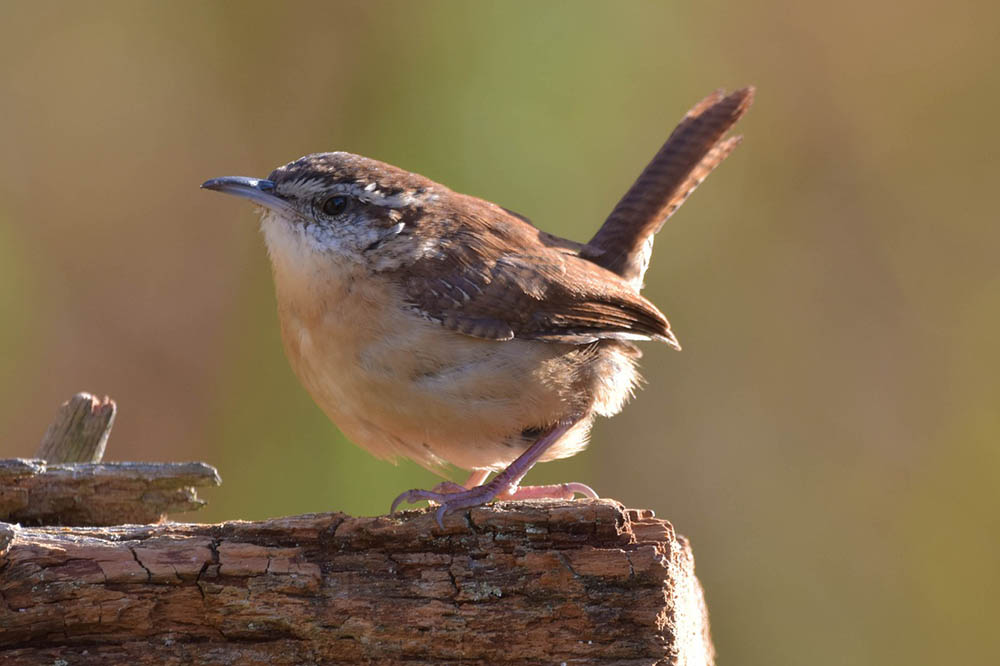
Out of all 50 states in the United States, Alabama ranks fifth in terms of biodiversity. For states that are east of the Mississippi River, Alabama ranks first, with more than 4,500 documented species. Of the 4,500 documented species, over 150 of them are birds.
If you live in Alabama and are a birdwatcher or just love birds in general, you’ve probably seen a lot of different bird species just in your own backyard. Maybe you want to correctly identify them or ensure that you provide the proper food so that they continue to come back.
In this article, we’ll look at 28 common backyard birds that are found in Alabama. We’ll also provide a picture and description of each one so that you can identify them as well as when and where they can be seen and what they commonly eat.

The 28 Most Common Backyard Birds in Alabama
1. American Crow
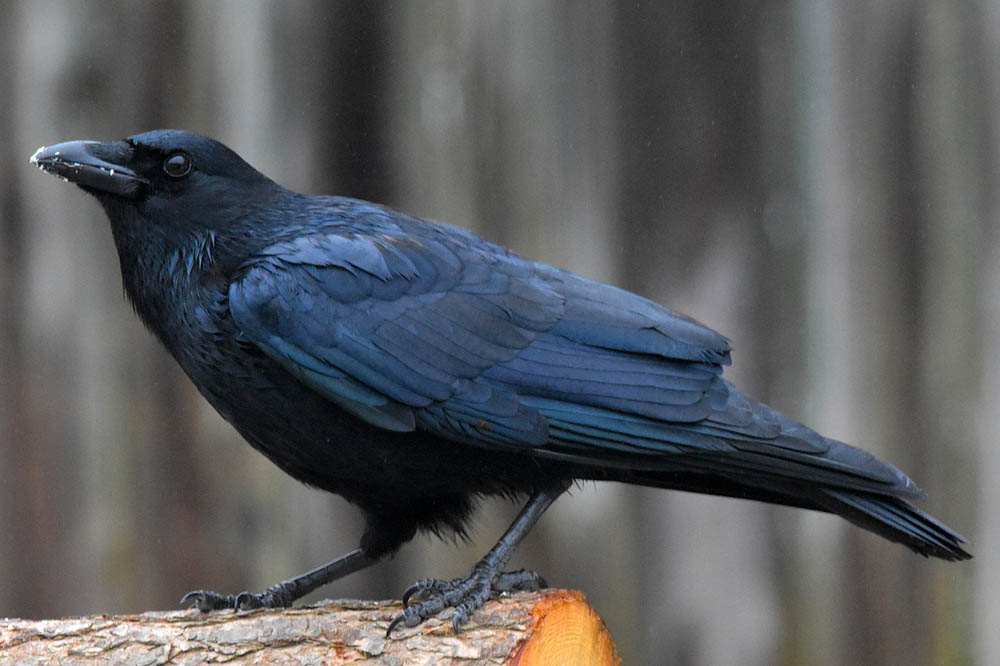
| Scientific Name: | Corvus brachyrhynchos |
| Other Names: | Common Crow |
| Season: | Year-round |
| Diet: | Earthworms, insects, seeds, fruit, small fish, clams |
The American Crow is the largest of the three crow species found in Alabama, with a length of 17-21 inches. It can be found in inland Alabama year-round but may be less common in coastal regions. American Crows are all-black in appearance and are commonly mistaken for ravens, but they can be distinguished from ravens by being slightly smaller and having a rounded tail and glossy appearance. Their “cawing” sound is easily recognizable. They are scavengers and can sometimes be a nuisance, so it’s important not to leave garbage or pet food outside that may otherwise attract more of them.
2. American Goldfinch
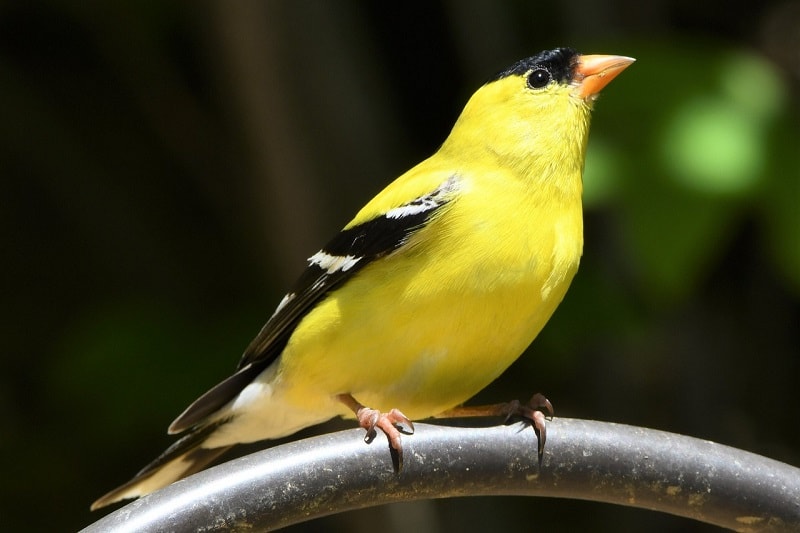
| Scientific Name: | Spinus tristis |
| Other Names: | N/A |
| Season: | Year-round |
| Diet: | Sunflower seeds, thistle seeds, nyjer seed |
American Goldfinches are smaller birds, at 4-5 inches in length. Males are bright yellow and black but turn a duller yellow-brown color in winter. Females are duller brown with pale yellow bellies. Goldfinches commonly forage for thistles and sunflower seeds and typically only visit bird feeders that contain these types of seeds.
3. American Robin
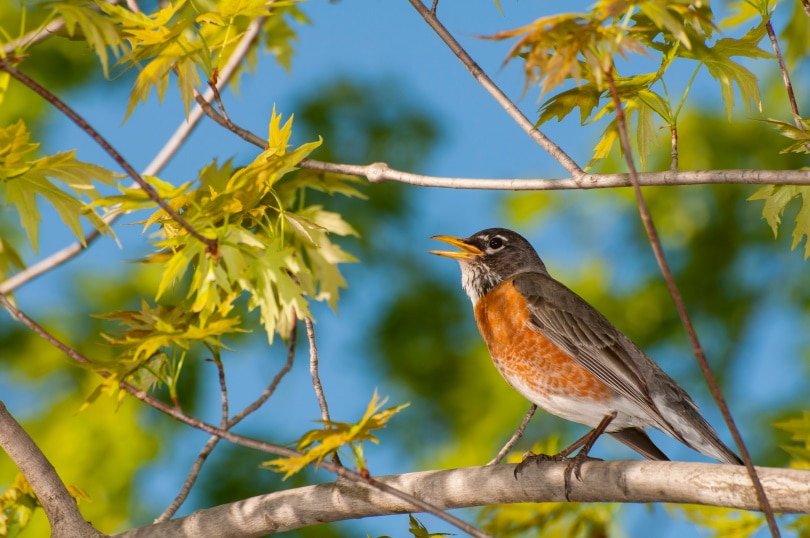
| Scientific Name: | Turdus migratorius |
| Other Names: | Robin Redbreast |
| Season: | Year-round |
| Diet: | Fruits, berries, earthworms, grubs, grasshoppers, insects |
The American Robin is a medium-sized bird that ranges from 8-11 inches in length. Their black heads and back along with their orange or red-orange breast and belly are easily recognizable, and although they live in your backyard year-round, they are most commonly seen in spring after emerging from their roosts in trees after winter. Earthworms are a main source of food for robins, but they will also eat sunflower seeds, suet, fruit, and mealworms that are scattered on the ground.
4. Blue Jay
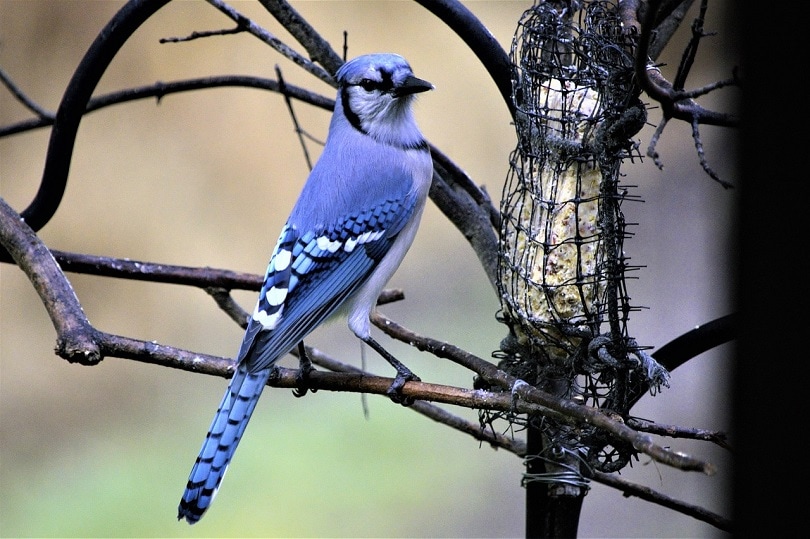
| Scientific Name: | Cyanocitta cristata |
| Other Names: | N/A |
| Season: | Year-round |
| Diet: | Acorns, nuts, insects, seeds, grain |
Blue Jays range from 10-12 inches in length and are year-round visitors to backyards in Alabama, although they are most commonly seen in spring and fall. If you live in a forested area, you are more likely to see a Blue Jay as they typically eat acorns and other nuts as a main source of food. However, they may also eat eggs out of other bird nests. Blue Jays can be recognized by their blue crests, black and blue tail and wings, and white belly. They can be noisy as they often alert other birds of larger predators. Blue Jays often like bird baths as well.
5. Brown-Headed Cowbird
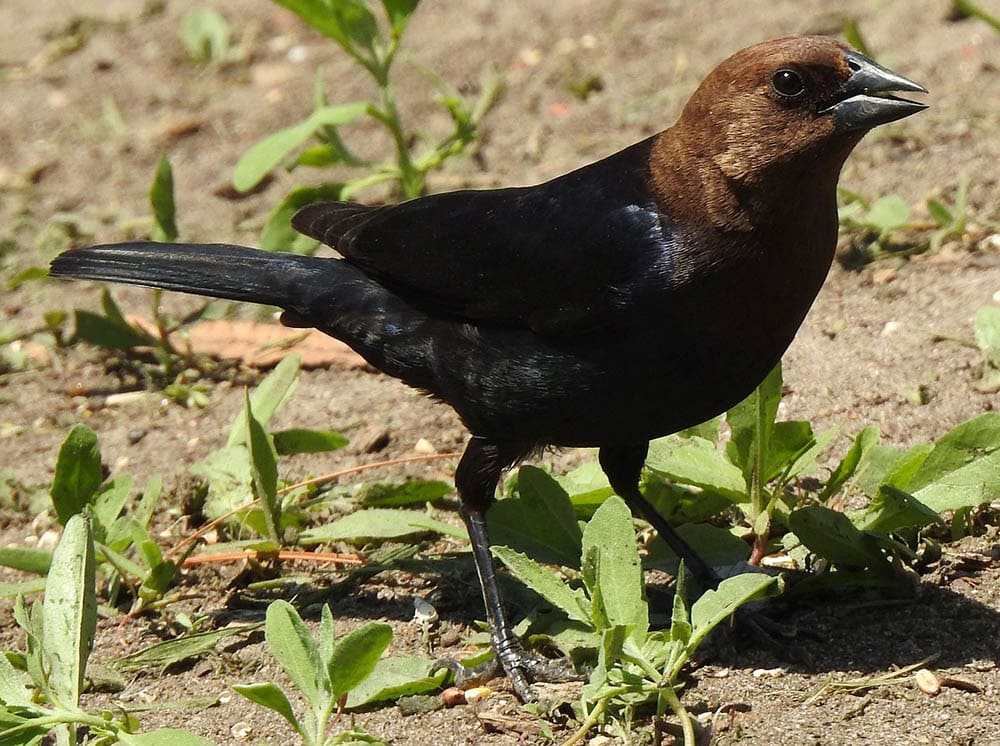
| Scientific Name: | Molothrus ater |
| Other Names: | Cowbird |
| Season: | Year-round |
| Diet: | Seeds and insects |
You’re more likely to see a Brown-Headed Cowbird if you live near a farm, field, or wood edge as they prefer open to semi-open spaces. These birds range from 7.5-9 inches in length. Males are typically black with a brown head, while females are a lighter brown all over their bodies. They feed mostly on seeds and insects, but you may want to avoid attracting them to your yard as they often lay their eggs in the nests of smaller songbirds, destroying the existing eggs in the process.
6. Brown-Headed Nuthatch
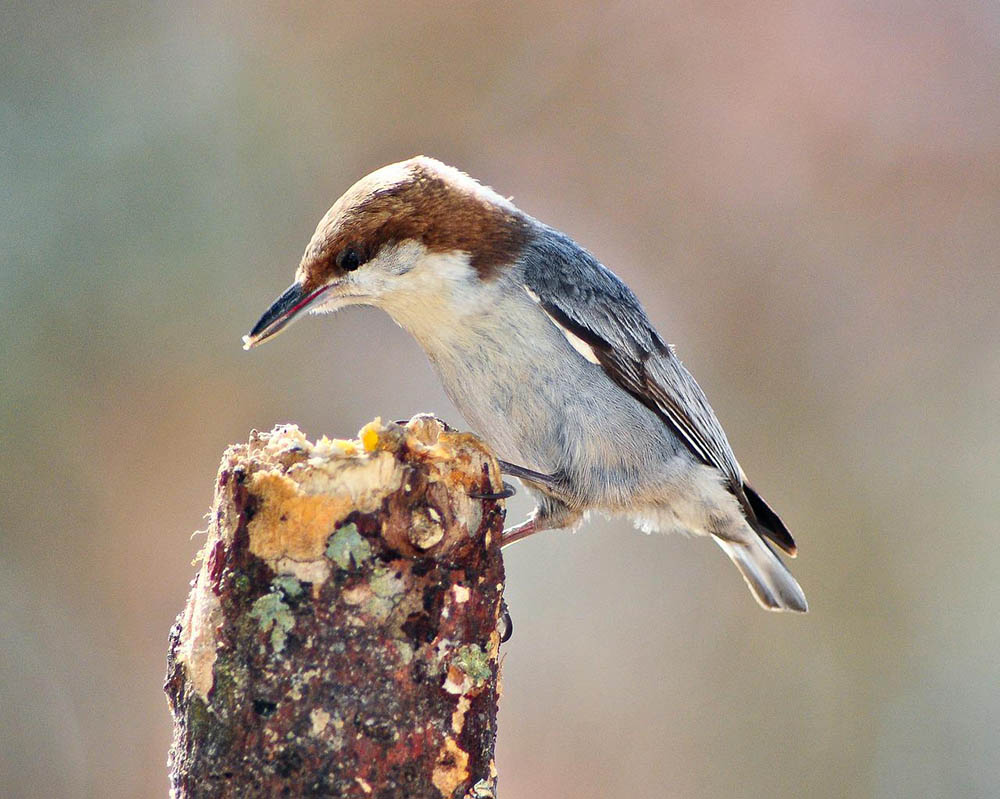
| Scientific Name: | Sitta pusilla |
| Other Names: | N/A |
| Season: | Year-round |
| Diet: | Insects and pine seeds |
Brown-Headed Nuthatches are found mostly in pine forests in Alabama. They are small birds that are only 4-4.5 inches long. They have a brown “cap”, black beak, blue-gray back, and light-colored chest. The noise they make is a squeaking sound that is similar to a rubber duck. You can attract them to your yard by providing sunflower seeds and suet or by planting fruit bushes and trees that produce nuts.
7. Carolina Chickadee
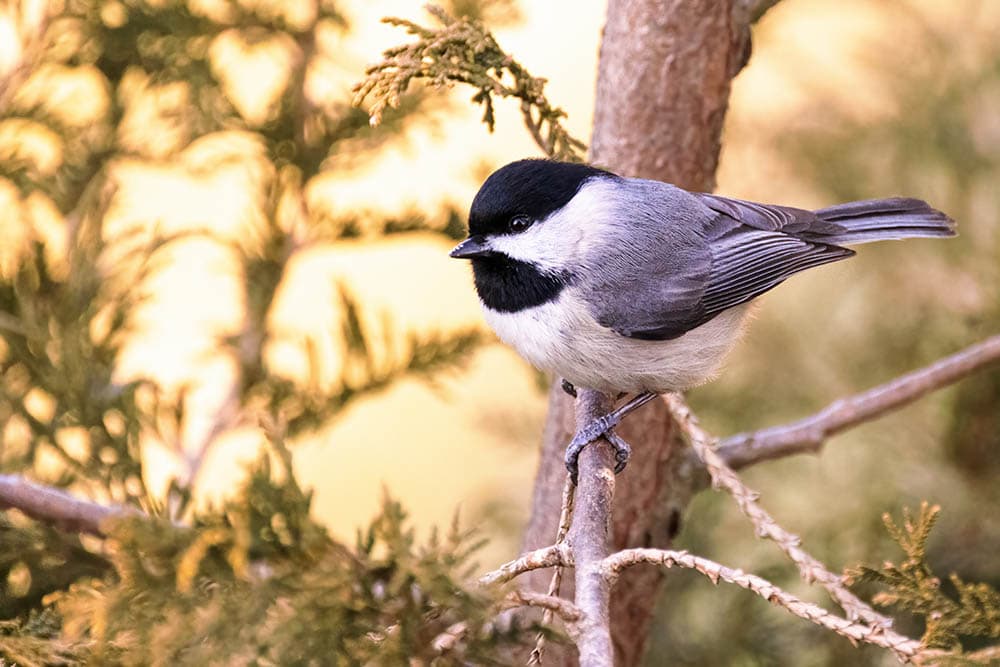
| Scientific Name: | Poecile carolinensis |
| Other Names: | N/A |
| Season: | Year-round |
| Diet: | Seeds |
Carolina Chickadees are tiny birds that are only 4-5 inches in length. Their diet consists mostly of seeds, and you can attract them to your yard with pretty much any type of birdseed. These birds have large heads with a black “cap” and neck that fades to gray down their back, wings, and tail. They have a white belly. Carolina Chickadees are one of the most common Alabama songbirds and they have a fast and high-pitched call.
8. Carolina Wren
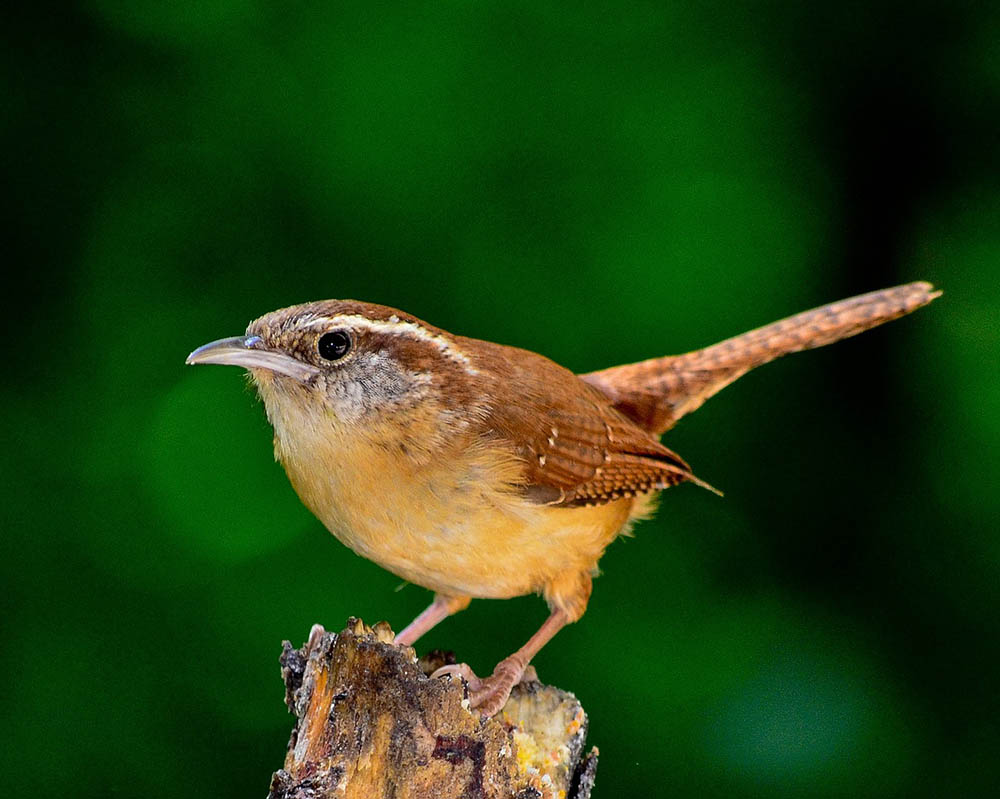
| Scientific Name: | Thryothorus ludovicianus |
| Other Names: | Great Carolina Wren, Mocking Wren, Florida Wren |
| Season: | Year-round |
| Diet: | Insects, spiders, caterpillars, grasshoppers, crickets |
Carolina Wrens range from 4.5-5.5 inches in length. They are brown-reddish brown on top with lighter brown bellies. They can also be recognized by their white “eyebrow” stripe and upright tail. Carolina Wrens are shy birds that like to hide in bushes and brush. Sometimes the only way to know you have a wren in your yard is to stumble across their nest, which they often make in brush piles or overgrown plants; areas where they can stay well-hidden. Their song sounds like “Teakettle.”
9. Chipping Sparrow

| Scientific Name: | Spizella passerina |
| Other Names: | N/A |
| Season: | Summer, some year-round |
| Diet: | Seeds and insects |
Chipping Sparrows are another small bird species that are 4.5-6 inches long. Some chipping sparrows remain in Alabama all year, but they are most commonly seen in summer. They have a “puffy” appearance with a long, slender tail. The head has a rust-colored cap and black eye-line, the belly is gray, and the wings are black and brown striped. These colors become duller in the winter. Chipping sparrows are one of the most common brown birds in Alabama. Chipping Sparrows are commonly seen feeding in the open and you can attract them to your yard with pretty much any type of birdseed.
10. Common Grackle
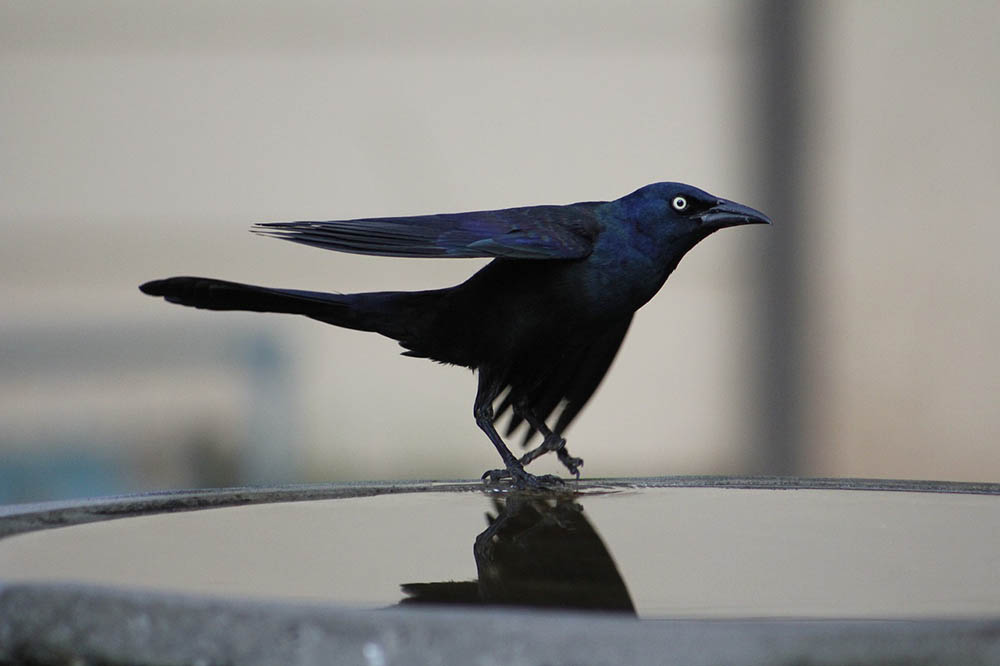
| Scientific Name: | Quiscalus quiscula |
| Other Names: | N/A |
| Season: | Year-round |
| Diet: | Seeds and grains |
Common Grackles are large birds that are 11-13.5 inches in length. They are in the blackbird family but their coloring is more of an iridescent indigo blue than black, especially on their head when the light hits just right. You can also tell them apart from other blackbirds due to their yellow-ringed eyes. Although Common Grackles eat mostly seeds and grains such as corn, they may also forage through garbage just like grows do, so some people see them as nuisances.
11. Downy Woodpecker

| Scientific Name: | Picoides pubescens |
| Other Names: | N/A |
| Season: | Year-round |
| Diet: | Insects, beetle larvae, acorns, grains, berries |
Downy Woodpeckers are 5.5-7 inches in length. They are black and white with spotted patterns on their wings. They have white bellies and the males have a red patch on the back of their heads. It can be hard to tell the difference between a Downy Woodpecker and another type of woodpecker, a Hairy Woodpecker, but downy woodpeckers are generally smaller.
12. Eastern Bluebird
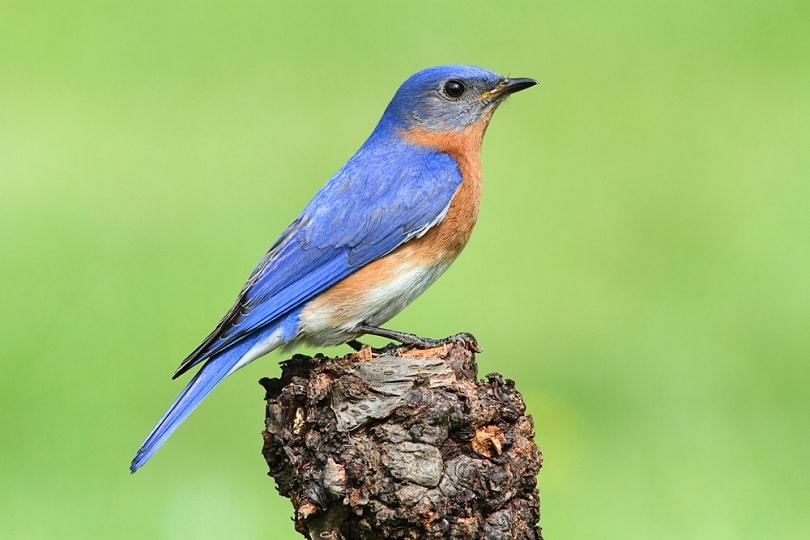
| Scientific Name: | Sialia sialis |
| Other Names: | N/A |
| Season: | Year-round, more common in winter |
| Diet: | Mostly insects |
Eastern Bluebirds are 6-8 inches in length. They are common year-round in Alabama, but you may see more of them during winter as they migrate to the south from the north. Males are a very vivid blue on their backs with a reddish-orange color underneath and a white belly. Females have muted blues and grays on their heads and back with a faded orange color underneath and a white belly. They eat mostly insects, so you can attract them to your yard by providing mealworms.
13. Eastern Phoebe

| Scientific Name: | Sayornis phoebe |
| Other Names: | N/A |
| Season: | Winter, some year-round |
| Diet: | Flying insects, spiders, small fruit, seeds |
Eastern Phoebes range from 5.5-6.5 inches in length. Although they are more commonly seen in winter in Alabama as they migrate south, some may remain all year. You’re more likely to see an Eastern Phoebe alone rather than with a flock of other birds. Males and females have backs that are grayish-brown. They have white undersides and a darker brown head. These birds are very beneficial to have around as they catch flies. You can attract more to your yard by planting native berries or providing a nest box close to your house
14. Eastern Towhee

| Scientific Name: | Pipilo erythrophthalmus |
| Other Names: | Chewink, Swamp Robin, Bullfinch, Red-Eyed Towhee |
| Season: | Year-round |
| Diet: | Seeds and insects |
Eastern Towhees are a larger species of sparrow that ranges 7-8 inches in length. They’re similar in size to a robin. Male Eastern Towhees have a black head, throat, and back while females have a brown head, throat, and back. Both males and females have reddish-orange sides and white bellies. Eastern Towhees are often seen foraging for seeds and can be attracted to your yard with sunflower seeds.
15. House Finch
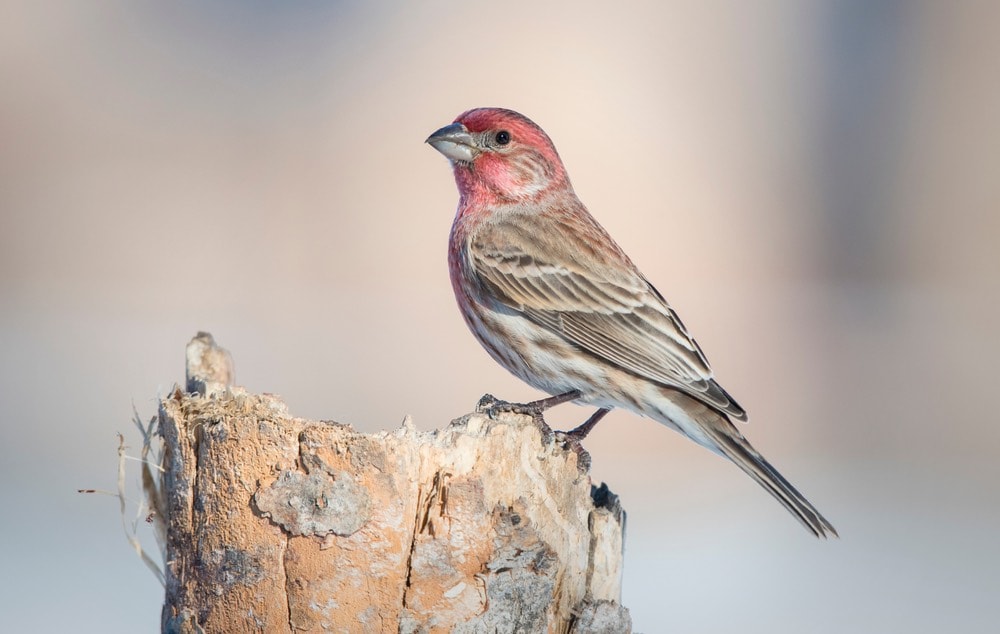
| Scientific Name: | Haemorhous mexicanus |
| Other Names: | N/A |
| Season: | Year-round |
| Diet: | Seeds, buds, and fruit |
House Finches are around 5-5.5 inches in length. These birds weren’t always common in Alabama, as they were native to western states. After being introduced to eastern states, they have done well and can now be seen year-round. Males have a red head and breast with a brown-streaked back. Females are just brown-streaked. They eat mostly seeds, buds, and fruit, particularly thistle seeds (nyjer seeds) and cherries, apricots, blackberries, strawberries, and figs.
16. Indigo Bunting

| Scientific Name: | Passerina cyanea |
| Other Names: | N/A |
| Season: | Spring, summer, fall; less common in winter |
| Diet: | Seeds and insects |
Indigo Buntings are small birds, ranging only 4.5-5 inches in length. They are most common in Alabama in spring, summer, and fall, but once temperatures start to cool off, they migrate farther south for warmer weather. Males are a bright blue color with black streaks on their wings and tails. Females are brown. They’re most likely to be seen in areas with heavy weeds or shrubs. Providing thistle and nyjer seed can attract more of them to your yard.
17. Magnolia Warbler

| Scientific Name: | Setophaga magnolia |
| Other Names: | N/A |
| Season: | Fall and spring, sometimes summer |
| Diet: | Caterpillars, insects, and spiders |
Magnolia Warblers are 4.5-5 inches long. They are not a year-round backyard bird species in Alabama, but they are common in the fall and spring when temperatures are milder. Both males and females have bright yellow bellies and black and white-striped wings and tails. Females have a solid gray head while males have a gray and white head with black bands across their eyes.
18. Mourning Dove
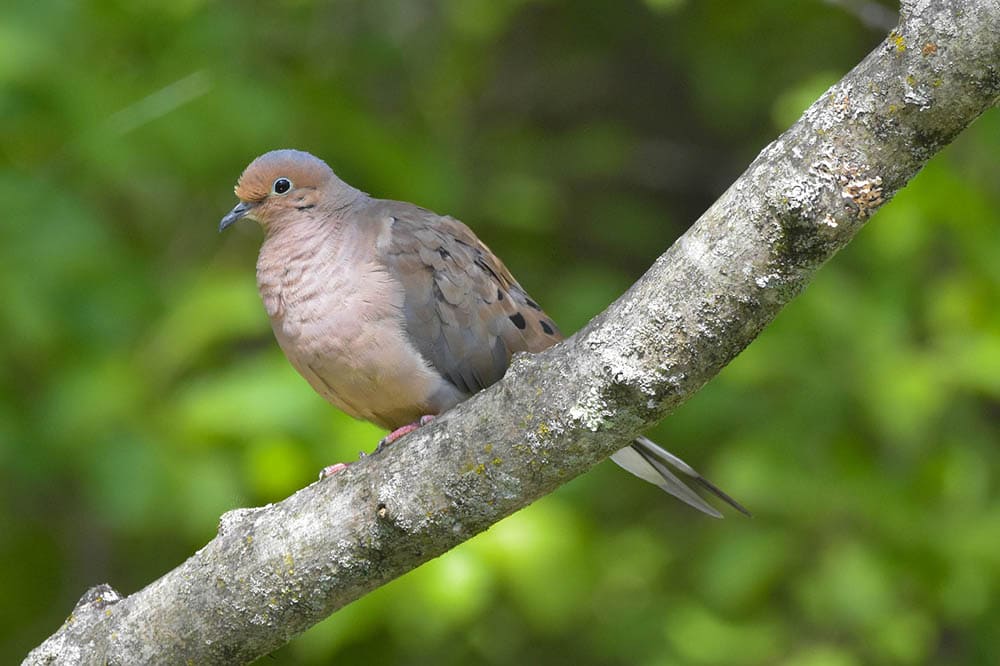
| Scientific Name: | Zenaida macroura |
| Other Names: | N/A |
| Season: | Year-round |
| Diet: | Seeds |
Mourning Doves are large birds, ranging from 9-14 inches. They have small heads and thin beaks, but plump bodies and long tails. Their main coloring is brown with black spots on the wings. Mourning doves are perching birds and are easily recognizable by their call, which sounds like, “Coo-coo, coo, coo, coo.” This call is heard most often in the spring. They eat mostly seeds and you can attract them to your yard with a variety of birdseed types.
19. Northern Cardinal
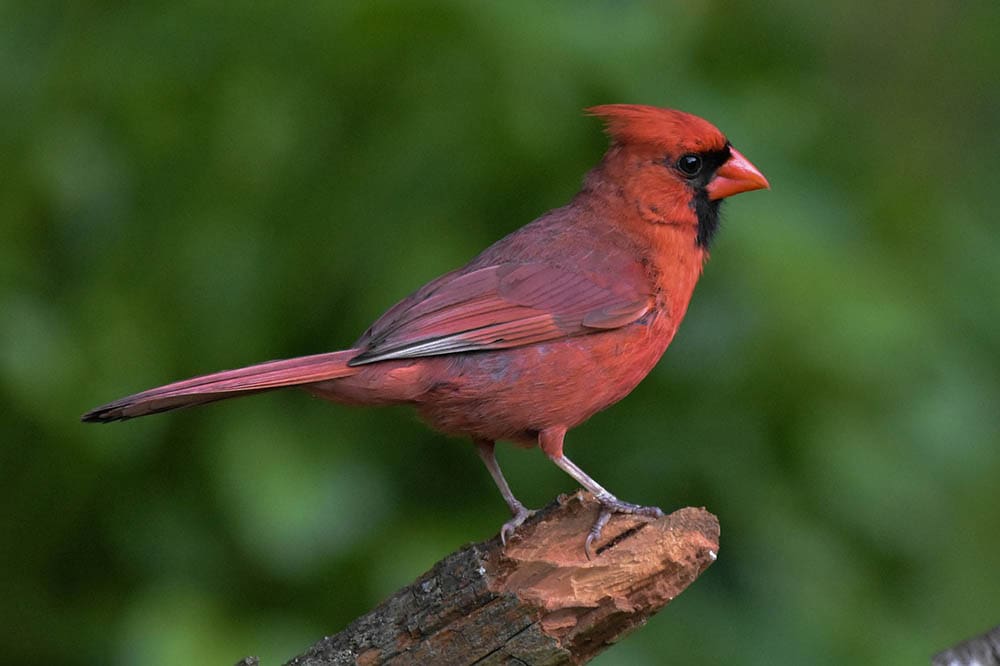
| Scientific Name: | Cardinalis cardinalis |
| Other Names: | N/A |
| Season: | Year-round |
| Diet: | Insects, seeds, flowers, berries, fruit |
Northern Cardinals are 8-9 inches in length and are easily recognizable by their bright red coloration and sharp crest on the tops of their heads. They are the most common red birds in Alabama. Only the males are bright red, however, as females are mostly brown with the occasional red highlight. Northern Cardinals can be spotted year-round but are seen a lot in winter while other birds have migrated or are roosting. They eat mostly insects and seeds and will eat pretty much any birdseed that you provide.
20. Northern Mockingbird
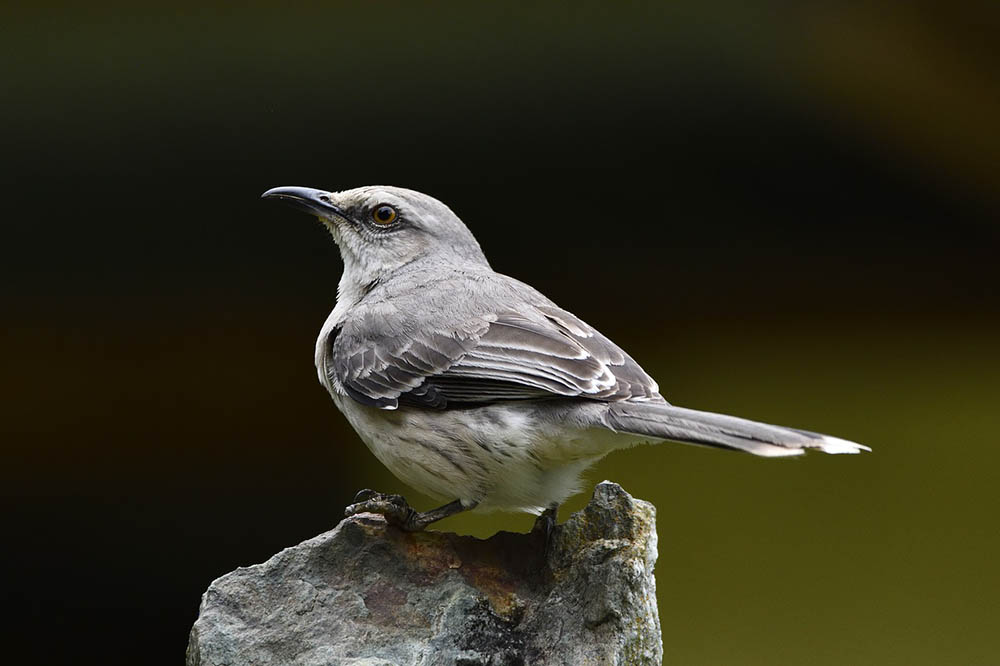
| Scientific Name: | Mimus polyglottos |
| Other Names: | N/A |
| Season: | Year-round |
| Diet: | Insects and berries |
Northern Mockingbirds can range from 8-10 inches in length. They are grayish-brown in color that fades to almost white on their underside. They have a prominent white stripe on each wing that can be seen even in flight to make these birds easily recognizable. Mockingbirds will aggressively defend their territory, and males copy other birds’ songs, hence their name. To attract Northern Mockingbirds to your yard, plant fruiting bushes such as blackberries and mulberries.
21. Pine Warbler

| Scientific Name: | Setophaga pinus |
| Other Names: | N/A |
| Season: | Year-round |
| Diet: | Caterpillars, beetles, spiders, insects, fruit, and seeds |
Pine Warblers are around 5.5 inches in length and are mostly found in pine forests. So, you’re more likely to see them in your backyard in Alabama if you have or live near pine trees. Their backs are an olive-green color and they have a yellow belly, chest, and head. Their wings are gray and white. Females are brownish-yellow and have more white on their bellies. You can attract them by planting native fruits and providing sunflower seeds, millet, and suet.
22. Purple Martin

| Scientific Name: | Progne subis |
| Other Names: | Gourd martin, black martin |
| Season: | Spring, summer, and fall; less common in winter |
| Diet: | Insects |
Purple Martins can be 7-8 inches in length and are members of the swallow family. In fact, they are the largest swallow species in Alabama. Males are a glossy, steel-blue color while females have duller backs and pale gray undersides. Both males and females have swept-back wings and a forked tail. Purple Martins eat mostly insects that they catch while in flight. They are great for insect control and you can attract them to your yard with gourd-style birdhouses.
23. Red-Bellied Woodpecker
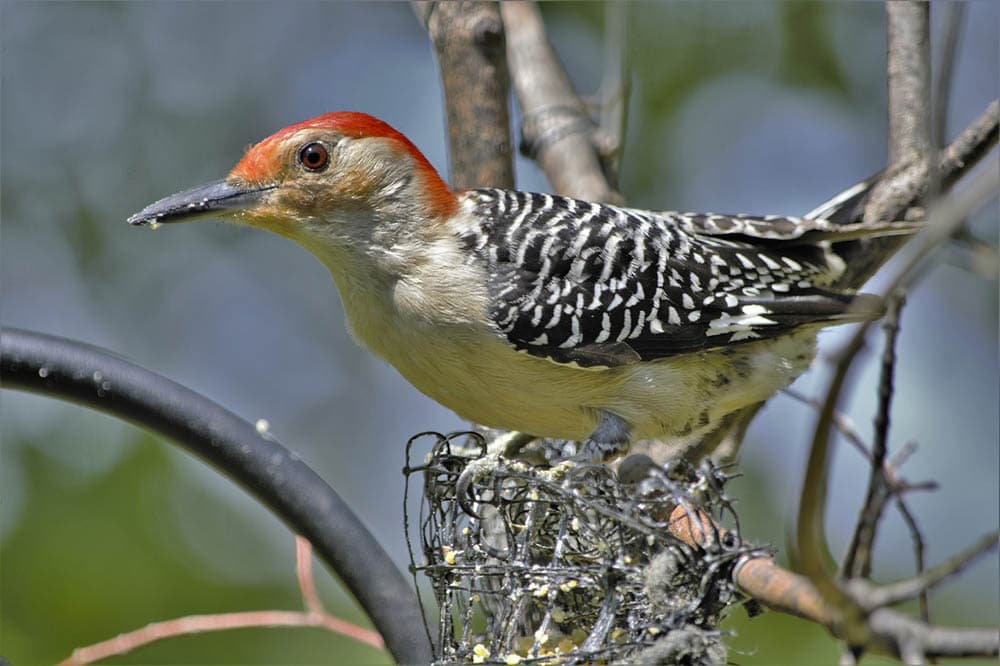
| Scientific Name: | Melanerpes carolinus |
| Other Names: | N/A |
| Season: | Year-round |
| Diet: | Insects, spiders, acorns, nuts, seeds |
Red-Bellied Woodpeckers are the most common woodpecker species in Alabama and are 9-10 inches in length. They’re so named for their bellies, which are light red or pink in color, but they’re hard to tell apart from other woodpeckers as their bellies are often hidden by tree trunks as the birds feed. Other distinguishing features are that the males have a red head and neck, which females lack. There is black and white barring on the backs of these birds.
24. Red-Headed Woodpecker
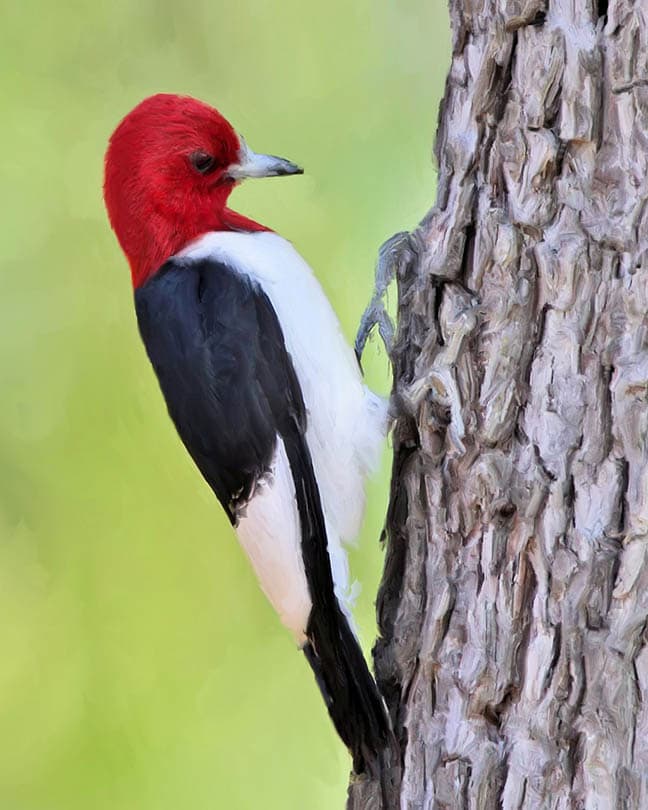
| Scientific Name: | Melanerpes erythrocephalus |
| Other Names: | N/A |
| Season: | Year-round |
| Diet: | Nuts, fruit, acorns, insects |
Red-Headed Woodpeckers are 8-10 inches in length and look very similar to the Red-Bellied Woodpecker. The differences between the two are that Red-Headed Woodpeckers have a head and neck that is entirely red, while red-bellied woodpeckers only have a red cap. The wings of a red-headed woodpecker are mostly black with large white sections closer to the tip. They lack black and white barring. Although they can be seen year-round in Alabama, they aren’t as common as other woodpeckers and are a moderative conservation concern.
25. Red-Winged Blackbird
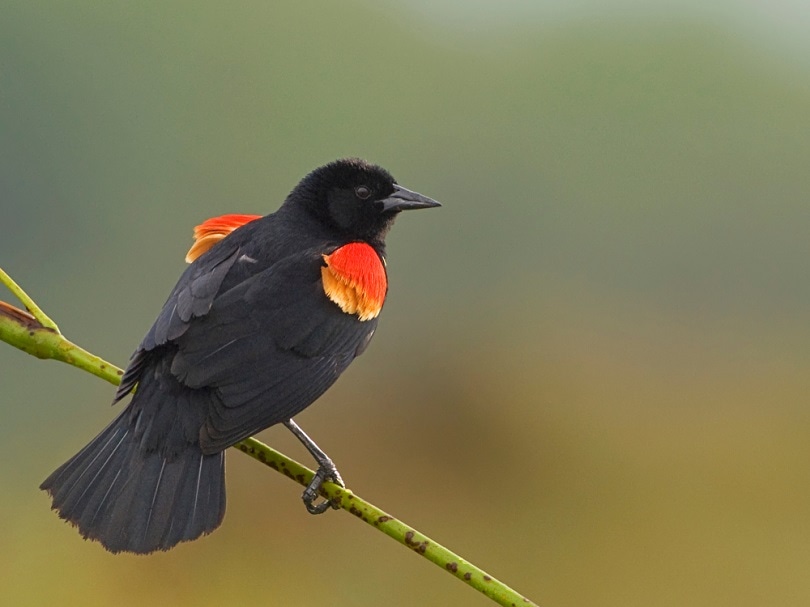
| Scientific Name: | Agelaius phoeniceus |
| Other Names: | Red Wing |
| Season: | Year-round |
| Diet: | Seeds and grains |
Red-Winged Blackbirds range from 7-9.5 inches in length. Males are mostly black with a red and yellow patch near the tops of their wings. Females have a coloring that resembles a sparrow, with brown and light-brown striping. Red-Winged Blackbirds can be aggressive and will defend their nests if someone or something gets too close. They are often seen roosting in large numbers during the winter.
26. Ruby-Throated Hummingbird
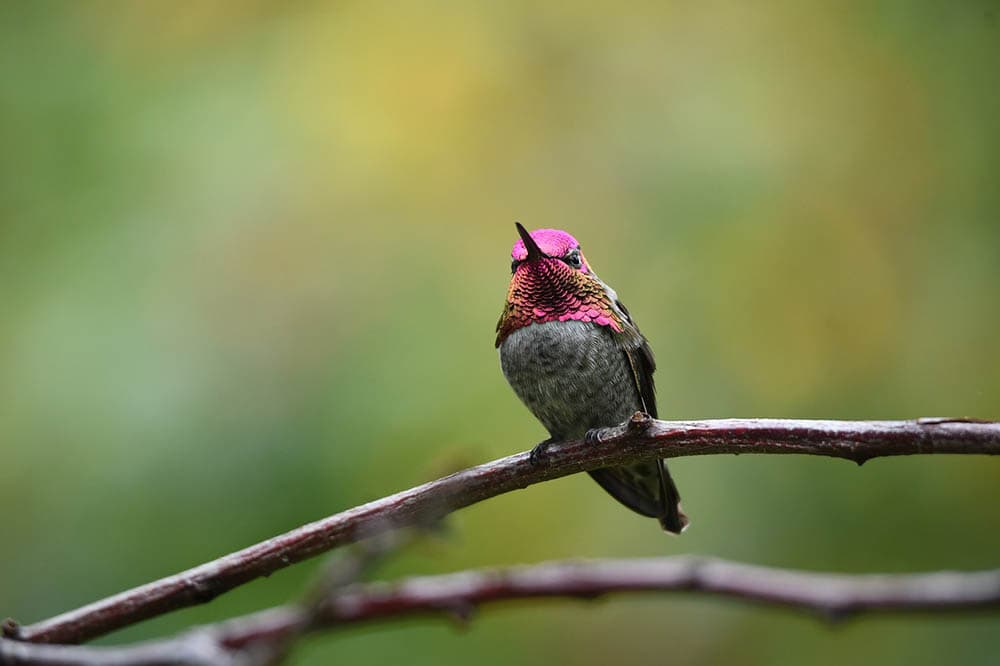
| Scientific Name: | Archilochus colubris |
| Other Names: | Common hummingbird, Ruby Throat |
| Season: | Spring, summer, and fall; less common in winter |
| Diet: | Nectar |
Ruby-Throated Hummingbirds are only around 3 inches in length. They are the only hummingbird that breeds in eastern North America, doing so mostly during the summertime. They migrate further south not long after temperatures cool down. Only males have a ruby-red throat, but both males and females are bright green on their backs with gray-white undersides. Male hummingbirds may be aggressive around food sources and become defensive, bullying other hummingbirds away. You can attract hummingbirds to your yard with feeders containing a mixture of sugar and water or by planting red or orange tubular flowers.
27. Tufted Titmouse
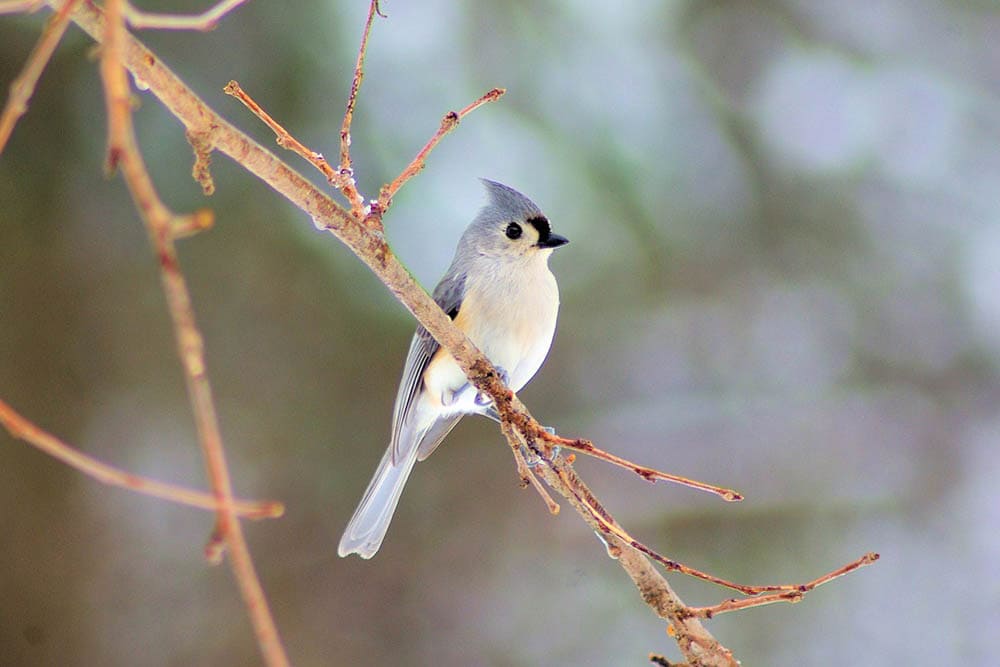
| Scientific Name: | Baeolophus bicolor |
| Other Names: | N/A |
| Season: | Year-round |
| Diet: | Insects, seeds, nuts, and berries |
The Tufted Titmouse can be 6-7 inches in length. Tufted Titmice have a gray back and crest with bright white bellies. They can often be seen in flocks with birds of a similar size, including Chickadees and Nuthatches, but they may be assertive over smaller birds. In the summer, these birds eat mostly insects and can help control ants and wasps. You can attract them to your yard with sunflower seeds and suet.
28. White-Breasted Nuthatch
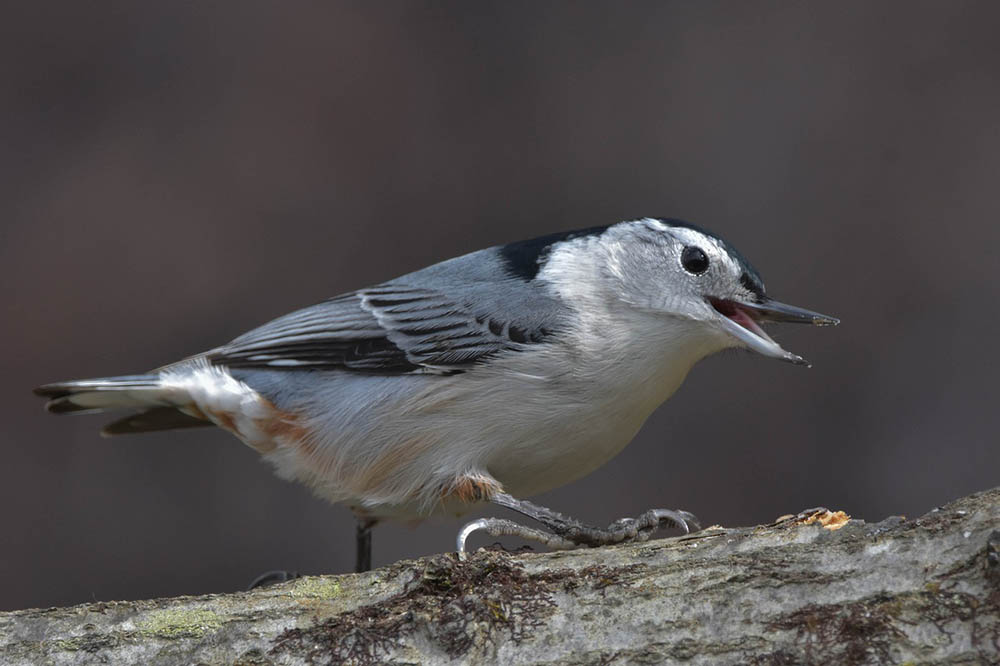
| Scientific Name: | Sitta carolinensis |
| Other Names: | N/A |
| Season: | Year-round in some regions, rare in others |
| Diet: | Insects, seeds, and nuts |
White-Breasted Nuthatches are around 6 inches in length. They are common mostly in North Alabama and are occasional or rare in other regions of the state. These birds have a black cap on their heads with a gray-blue back and white face and belly. The underside of the tail is a chestnut brown color. They are called Nuthatches due to the way that they whack large nuts against tree bark with their beaks to form a hatch to get the seed out. You can attract them with peanuts, sunflower seeds, or other nuts that they can hatch open.

In Conclusion
Alabama is a great place to live if you love birds, as there are many different species that regularly frequent your backyard all throughout the year, although some may be more common in certain seasons than others. Hopefully, this guide helped you to be able to identify the feathered visitors that commonly visit. Once you’ve identified them, you may even be able to attract more of them to your yard by providing foods that are part of their normal diet, whether that be through certain types of birdseed or planting native plants.
Featured Image Credit: JackBulmer, Pixabay
Table of Contents
- The 28 Most Common Backyard Birds in Alabama
- 1. American Crow
- 2. American Goldfinch
- 3. American Robin
- 4. Blue Jay
- 5. Brown-Headed Cowbird
- 6. Brown-Headed Nuthatch
- 7. Carolina Chickadee
- 8. Carolina Wren
- 9. Chipping Sparrow
- 10. Common Grackle
- 11. Downy Woodpecker
- 12. Eastern Bluebird
- 13. Eastern Phoebe
- 14. Eastern Towhee
- 15. House Finch
- 16. Indigo Bunting
- 17. Magnolia Warbler
- 18. Mourning Dove
- 19. Northern Cardinal
- 20. Northern Mockingbird
- 21. Pine Warbler
- 22. Purple Martin
- 23. Red-Bellied Woodpecker
- 24. Red-Headed Woodpecker
- 25. Red-Winged Blackbird
- 26. Ruby-Throated Hummingbird
- 27. Tufted Titmouse
- 28. White-Breasted Nuthatch
- In Conclusion
About the Author Savanna Stanfield
Savanna is a former science teacher who is now a full-time freelance writer currently living in the United States with her husband and daughter. Other members of her family include a long-haired chihuahua named Penny, three cats, and an aquatic turtle named Creek. In addition to writing, her passions include gardening, traveling, and protecting our wildlife and natural resources.
Related Articles:
Monocular vs Telescope: Differences Explained (With Pictures)
10 Types of Hummingbirds in Arkansas (With Pictures)
8 Types of Hummingbirds in Nebraska (With Pictures)
5 Types of Hummingbirds in Idaho (With Pictures)
3 Types of Hummingbirds in Mississippi (With Pictures)
8 Types of Hummingbirds in Kansas (With Pictures)
5 Types of Hummingbirds in West Virginia (With Pictures)
5 Types of Hummingbirds in Ohio (With Pictures)
